Food Allergies Statistics: Food allergies have become an increasingly prevalent health concern worldwide. This rise in food allergies has significant implications for public health and the food industry.
According to recent studies, millions of people are affected by food allergies, with the numbers continuing to grow.
These allergies can range from mild discomfort to life-threatening reactions, making it crucial to understand their prevalence and impact.
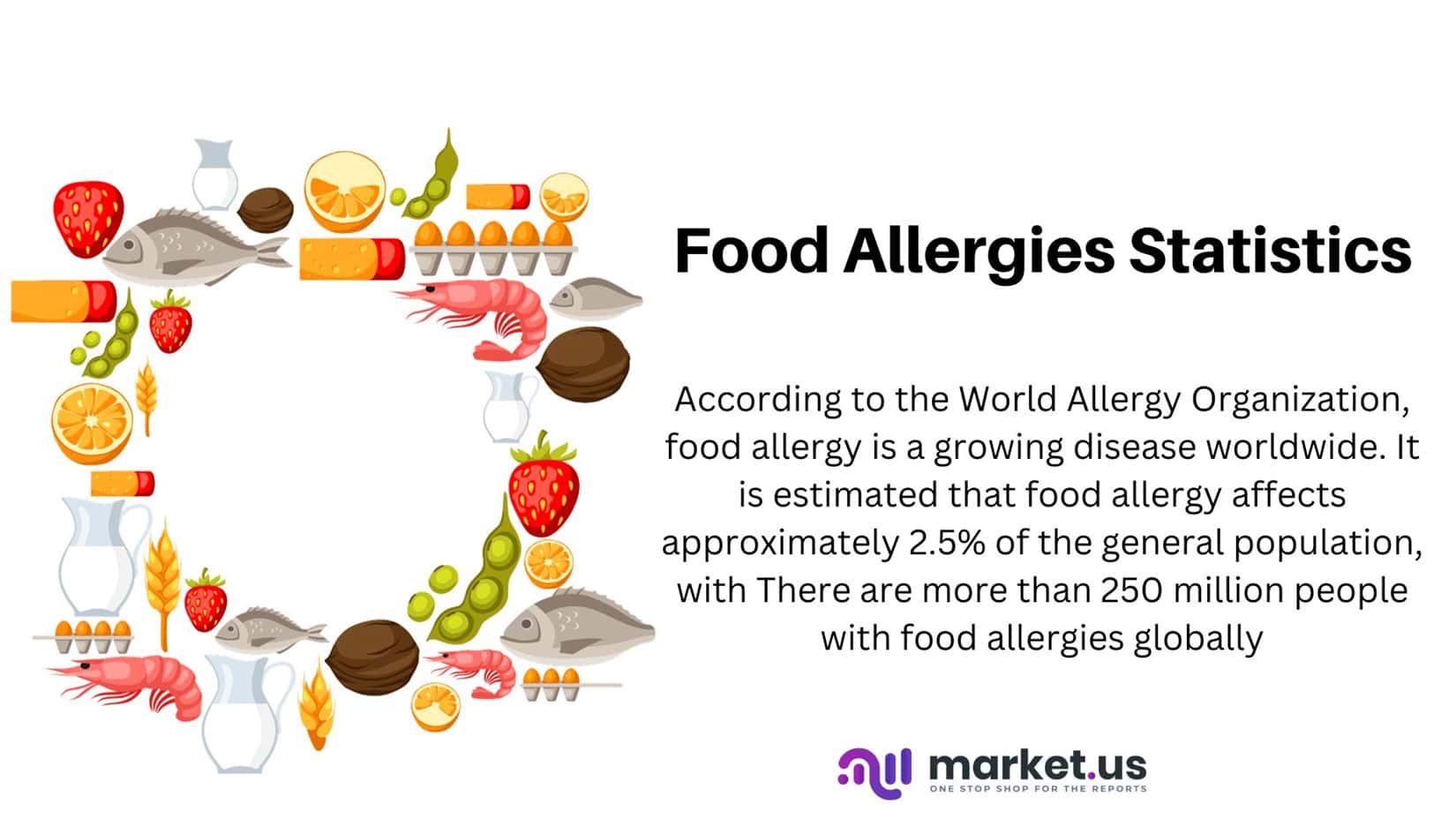
Table of Contents
- Curators Choice
- Most Common Food Allergens
- Food Allergies Statistics by Global Prevalence Rate
- Food Allergies Statistics by Allergen Type
- Food Allergies Statistics by Gender
- Allergies Statistics by Race/Ethnicity
- Food Allergies Statistics by Age
- Economic Burden of Food Allergies
- Common Symptoms of Food Allergies
- Final Thoughts
- FAQs
Curators Choice
- Food allergies affect about 2.5% of the general population, but their prevalence varies considerably – from 1- 10%.
- Milk, egg, wheat, fish, and nuts are among the many common allergenic foods that trigger hypersensitivity reactions even in trace amounts (hidden food).
- In the United States, approximately 32 million people report having a food allergy.
- Each year, around 200,000 people in the United States seek emergency medical care due to food allergies.
- Food allergies are particularly common among youth, with approximately 1 in every 13 children in the United States being diagnosed with a food allergy.
- Approximately 40% of children with food allergies in the United States are allergic to more than one type of food.

Most Common Food Allergens
Common Food Allergens: While virtually any food can theoretically trigger an allergic reaction, eight foods account for the majority of food allergies. These are often referred to as the “big eight” allergens:
- Peanuts
- Tree nuts (e.g., almonds, cashews, walnuts)
- Milk
- Eggs
- Soy
- Wheat
- Fish
- Shellfish (e.g., shrimp, crab)
Food Allergies Statistics by Global Prevalence Rate
- Allergy Diagnostics Market projected to increase significantly at a CAGR of 12% by 2026
- In the UK, approximately four percent (4%) Of children less than five years old in England have a confirmed food allergy.
- Denmark reports an incidence rate of 3.6% among children ages 9-11 for food allergies confirmed via challenge.
- Norway reports a prevalence rate of 6.8% among children under 5 years for food allergies that have been confirmed through challenge tests.
- Australian research indicates a prevalence rate of over 10% at 12 months old and around 4% by 4 years.
- In a Melbourne-based HealthNuts study, the prevalence of peanut allergy at 12 months ranged between 3.0%, egg allergy at 8.9%, and sesame allergy at 0.8%, with sesame allergies being relatively rare at 0.8%.
- At four-year follow-up in the HealthNuts study, peanut allergy prevalence was 1.9%, egg allergy was 1.2%, and sesame allergy 0.4%.
- A systematic review of 42 European studies from 2000 to 2012 reports the point prevalence of food allergies related to various allergens: cow’s milk (0.6%), egg (0.2%), wheat (0.1%), soy (0.3%), peanut (0.2%) tree nuts (0.5%) fish (0.1%) and shellfish (0.1%).
- The same systematic review reports the following estimates for lifetime prevalence: cow’s milk (6.0%), eggs (2.5%), wheat (3.6%), soy (0.4%), peanut (1.3%) tree nuts (2.2%) and fish (1.3%].
- An electronic survey in the US among self-report food allergy cases among children under 18 years of age reported an 8.0% prevalence rate, similar to what was found for Europe reported in a systematic review.
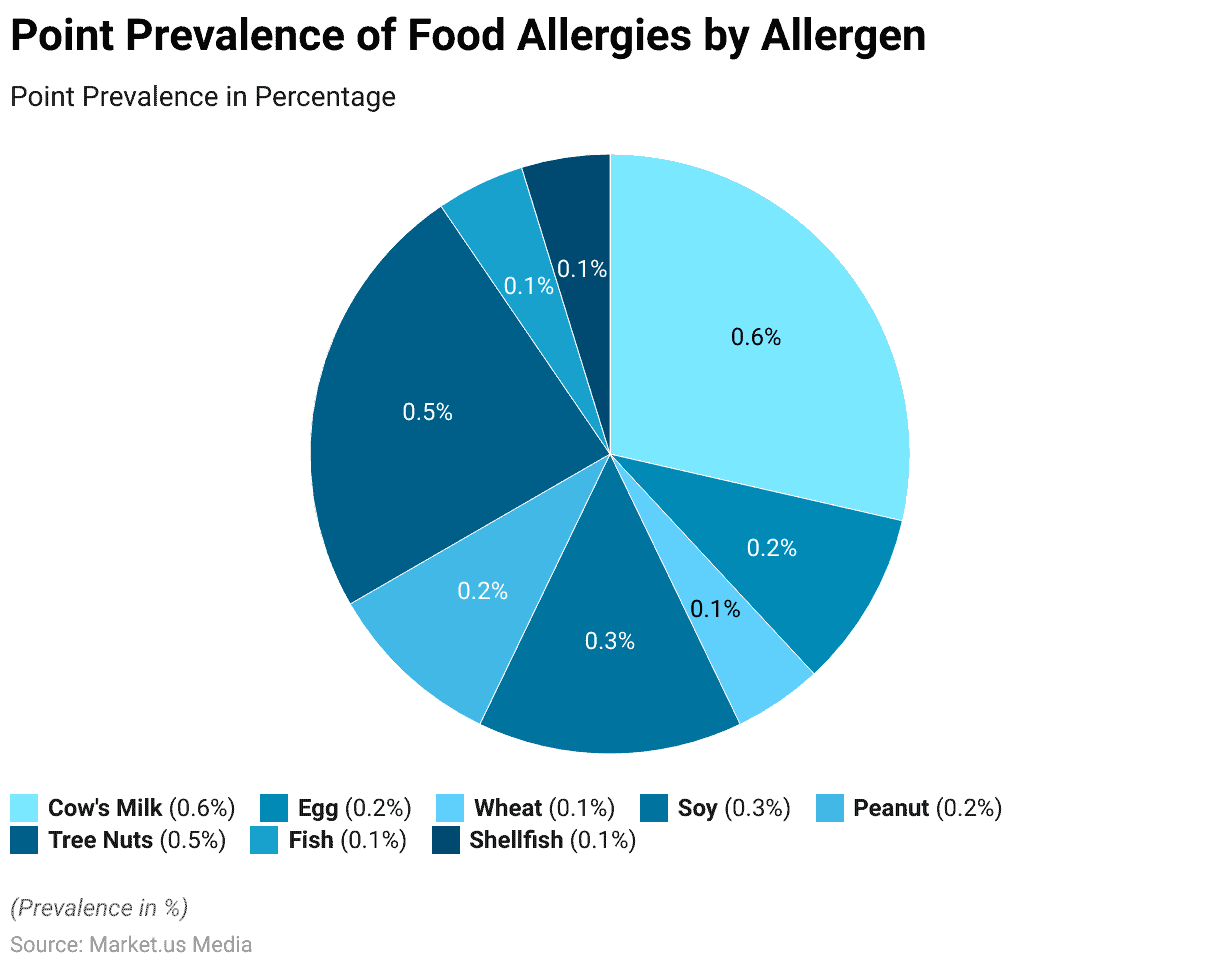

Food Allergies Statistics by Allergen Type
Peanut Allergies
- Peanut allergy is the second-most-common food allergy among children, affecting approximately 1 out of 50 children.
- Its prevalence among adults is significantly lower at roughly one out of 200; estimates indicate there may be one fatal case due to peanut allergy each time 200 episodes of anaphylaxis are triggered by it.
- PA currently affects about 2% of the general population. From 7-14% of patients living with PA are exposed to peanuts on an annual basis through accidental encounters; one-third to half may experience anaphylactic shock as a result
- In 2017, researchers revealed a 21% rise in peanut allergies among children compared to 2010. Furthermore, 2.5% of American children may have some type of peanut allergy. (Source: online library).
Cow Milk
- Cow’s milk allergy (CMA) is an international health issue affecting millions of individuals worldwide; an estimated total number affected is around 6.1 million people.
- The estimated prevalence of cow’s milk allergy (CMA) varies between 0.25% and 4.9%. This estimate takes into account that CMA can affect individuals of various age groups; children have a higher prevalence than adults.
- Cow’s Milk Allergy (CMA) is more prevalent among children than adults, affecting roughly 2-3% of infants and young children, reflecting its increased vulnerability among younger individuals (Source: ScienceDirect).
Eggs
- The overall prevalence of egg allergy is 0.9% of all children and 1.3% of children under 5 years of age in the US.
- For adults, the prevalence of reported egg allergic reactions in the United States is 0.6%.
- Egg allergy can occur as early as infancy, and most children, but not all, outgrow their egg allergy before adolescence.
- Approximately 2.6 million individuals in the United States are affected by egg allergies.
Fish
- Fish allergy affects up to 0.2% of the general population.
- The prevalence of fish allergy is higher in countries with high fish consumption and fish-processing industries.
- The prevalence of fish allergy varies from 0% to 7%, depending on the method of diagnosis.
- When food challenges are used for diagnosis, the prevalence of fish allergy is found to be between 0% to 0.3%.
- Self-reported fish allergy frequency is estimated to be approximately 1.5% in developed countries.
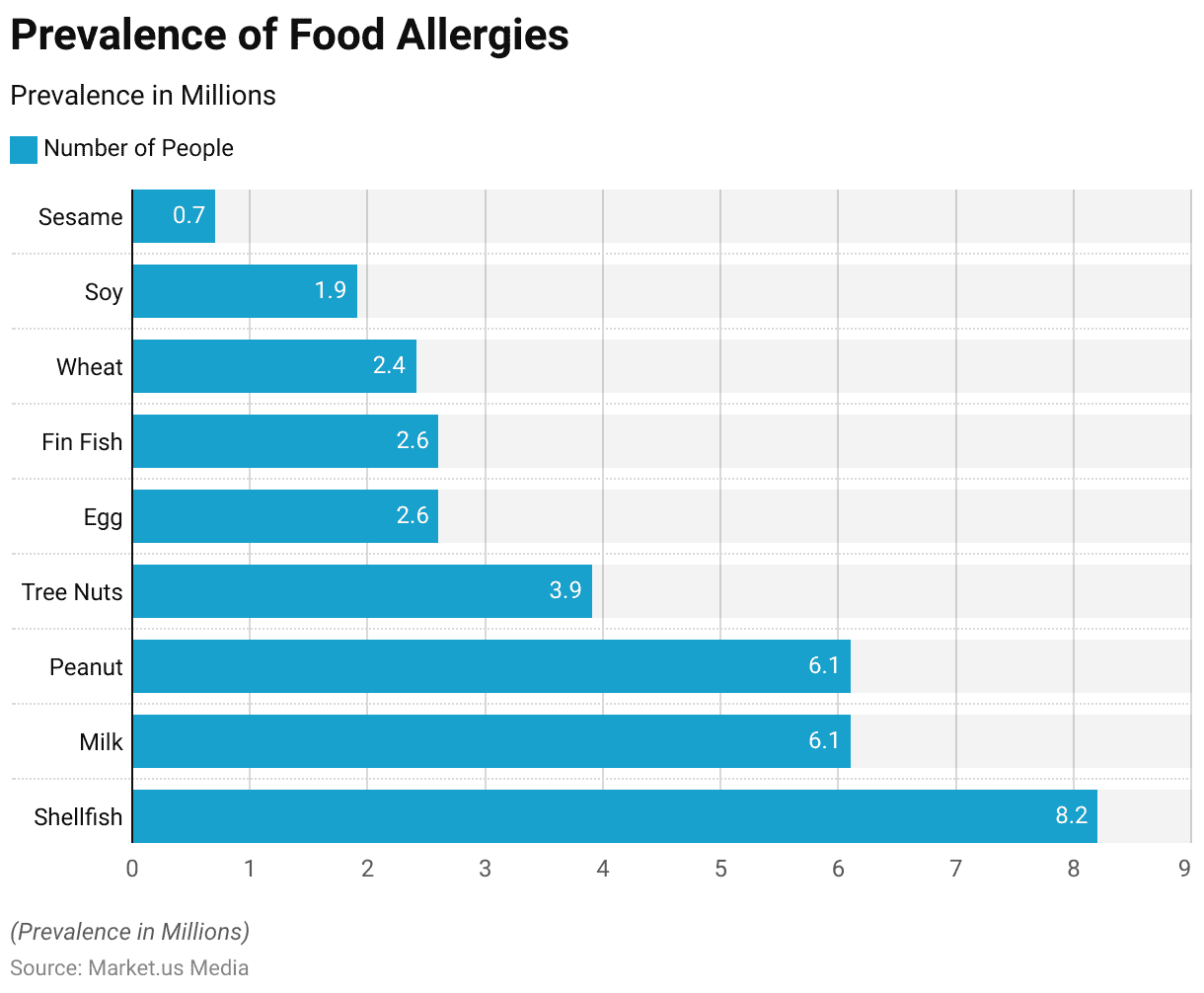
Food Allergies Statistics by Gender
- According to a study by Hindawi, In the case of children with food allergies, 64.35% were males, while 35.65% were females, resulting in a male/female ratio of 1.80.
- Contrastingly, within the adult population with food allergies, 34.82% were males, and a significant majority, 65.18%, were females, yielding a male/female ratio of 0.53.
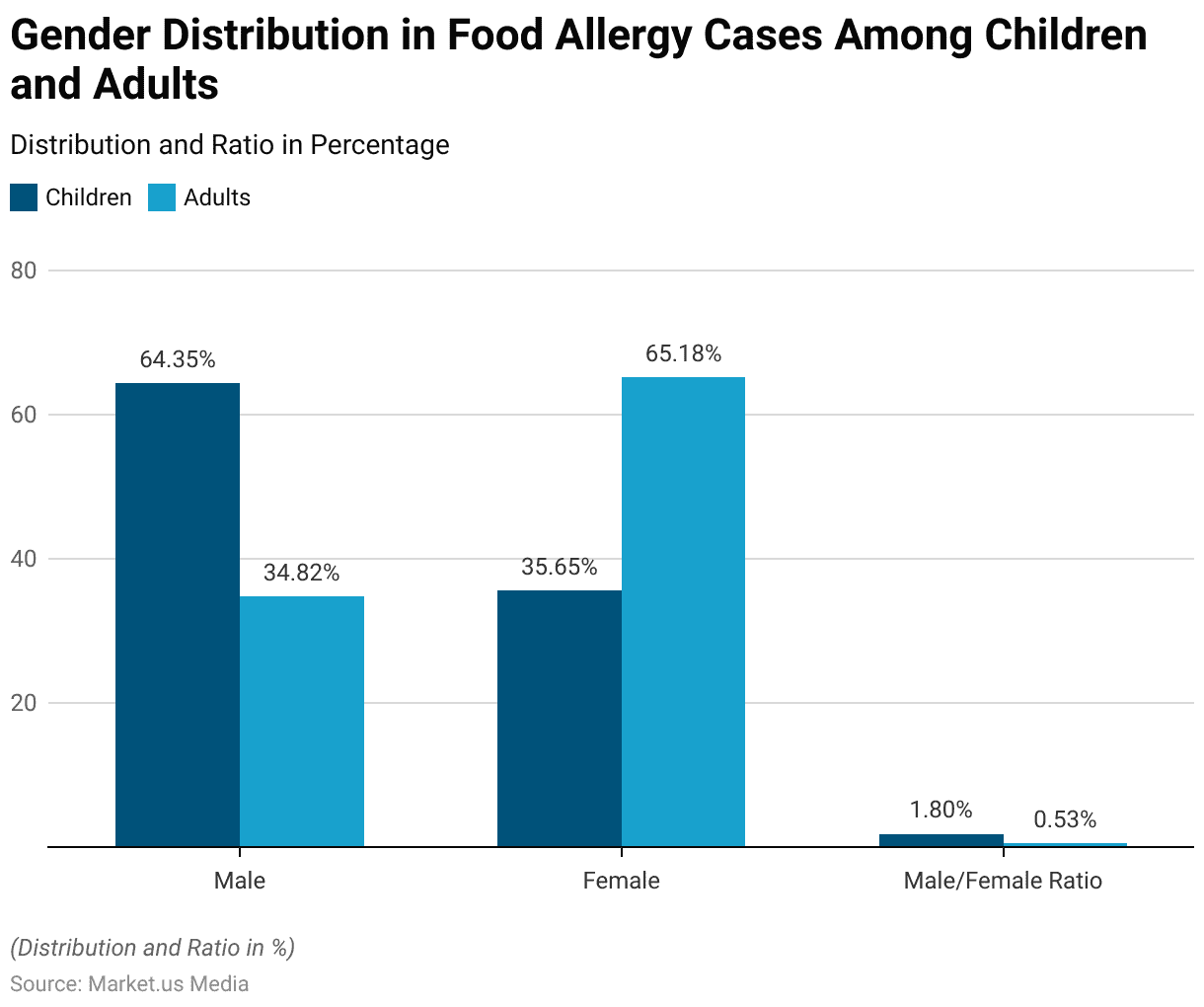
Allergies Statistics by Race/Ethnicity
- Asian Population: Asian individuals have the highest prevalence of food allergies with approximately 10.5% reporting allergies to various foods; this indicates a substantial portion of them suffer from food allergies.
- Hispanic Population: Food allergies are particularly prevalent among Hispanic people, affecting 10.6%. This statistic highlights their significant burden within Hispanic communities.
- Non-Hispanic Black Population: Food allergies are also highly prevalent among non-Hispanic Black individuals, at an equivalent rate to Hispanic individuals (10.6%). This indicates that non-Hispanic Black individuals face similar risks of food allergies as their counterparts. (Source: northwestern)
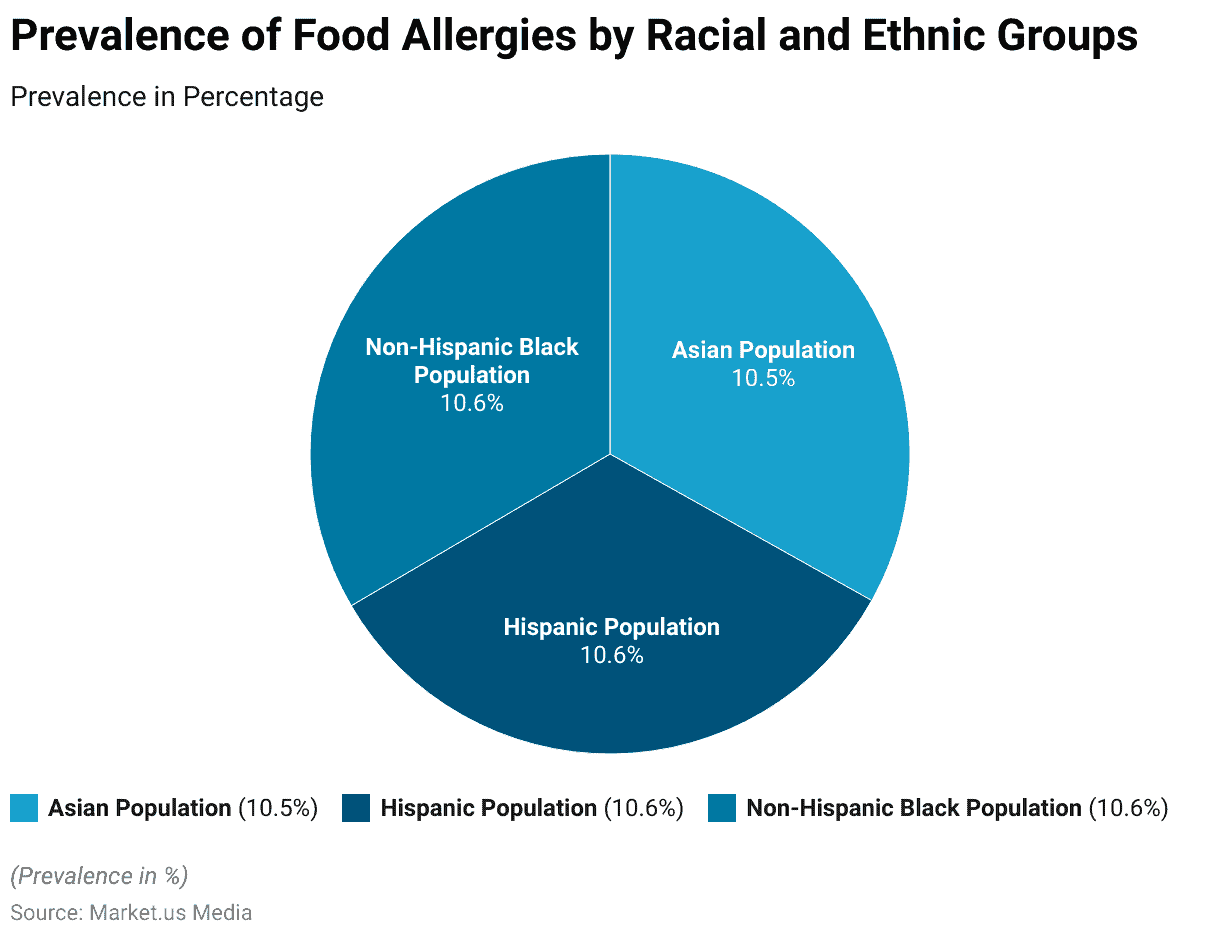
Food Allergies Statistics by Age
- Approximately 6% of children aged 0-2 years have been reported to have a food allergy.
- Among children aged 3-5 years, the prevalence of food allergies is higher, with about 9% of them having been diagnosed with a food allergy.
- In the age group of 6-10 years, nearly 8% of children are affected by food allergies.
- In the pre-teen years, approximately 8% of children aged 11-13 years have been identified as having food allergies.
- Among adolescents aged 14-18 years, the prevalence of food allergies increases further, with more than 8.5% of them reported to have a food allergy.
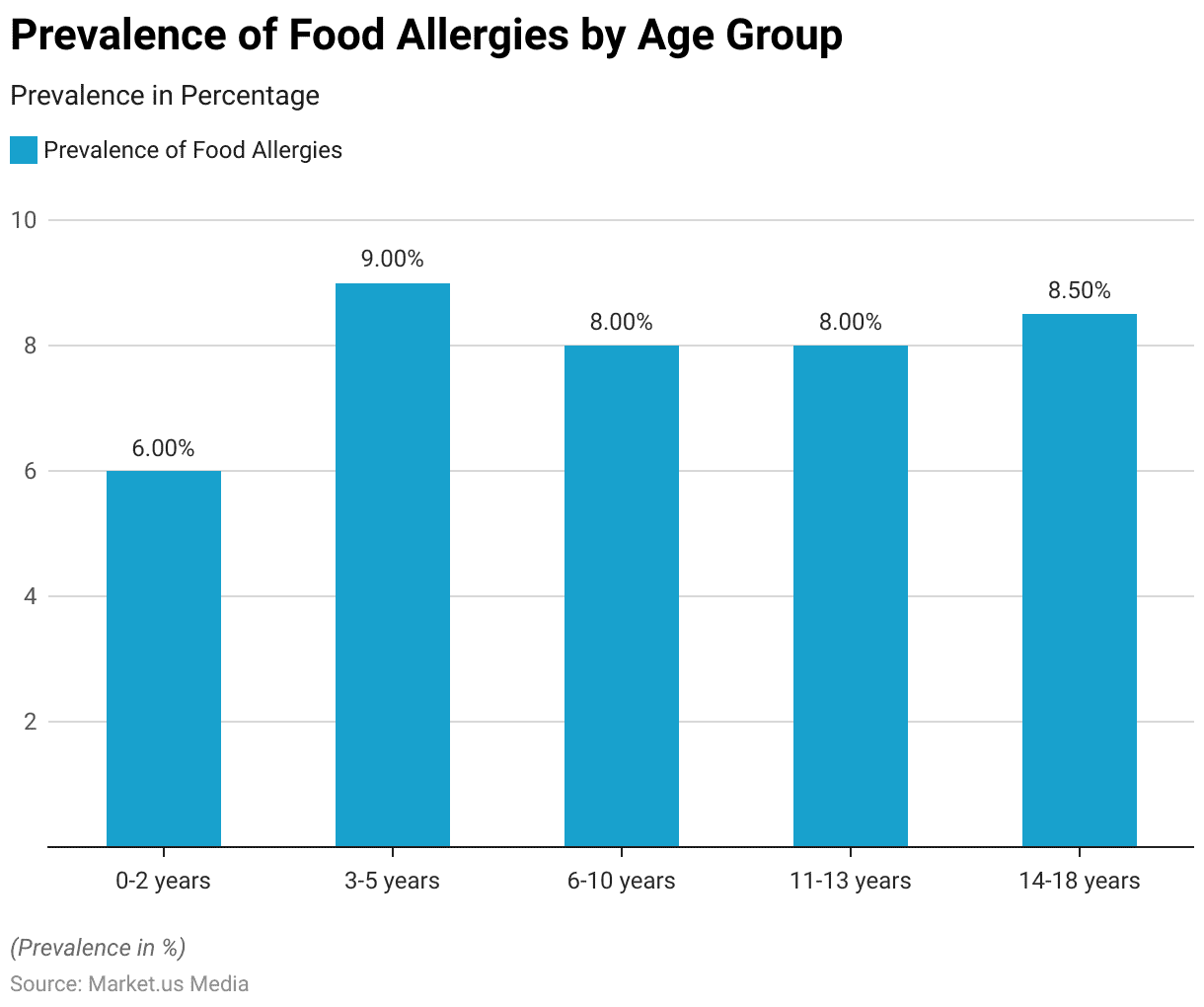
Economic Burden of Food Allergies
- It has been estimated that food allergies cost the economy an estimated annual cost of $24.8 billion with a 95% confidence interval (CI) range from $20.6 to $29.4 billion.
- On average, food allergies cost an average of $4,184 annually per child.
- Annual direct medical costs associated with food allergies were estimated to total $4.3 billion, with a 95% confidence interval ranging between $2.8 and $6.3 billion. This amount includes expenses such as clinician visits, emergency department visits, and hospitalizations.
- Families experienced total annual costs associated with food allergies of $20.5 billion, including lost labor productivity, out-of-pocket expenses, and missed opportunities.
- It has been estimated that lost labor productivity costs approximately $0.77 billion each year, with a 95% confidence interval ranging between $0.53 billion and $1.0 billion. This cost estimate takes into account caregiver’ time off work due to food allergy appointments for their children.
- Families spent an estimated annual total of $5.5 billion on out-of-pocket expenses related to food allergies, with 31% attributable to special foods purchases.
- Estimates of opportunity costs related to caring for children with food allergies were estimated at an annual estimate of $14.2 billion with a 95% confidence interval ranging between $10.5 and $18.4 billion.
- Caregivers reported being willing to spend $20.8 billion each year for food allergy treatment for their children, which translates to roughly $3,504 annually per child.
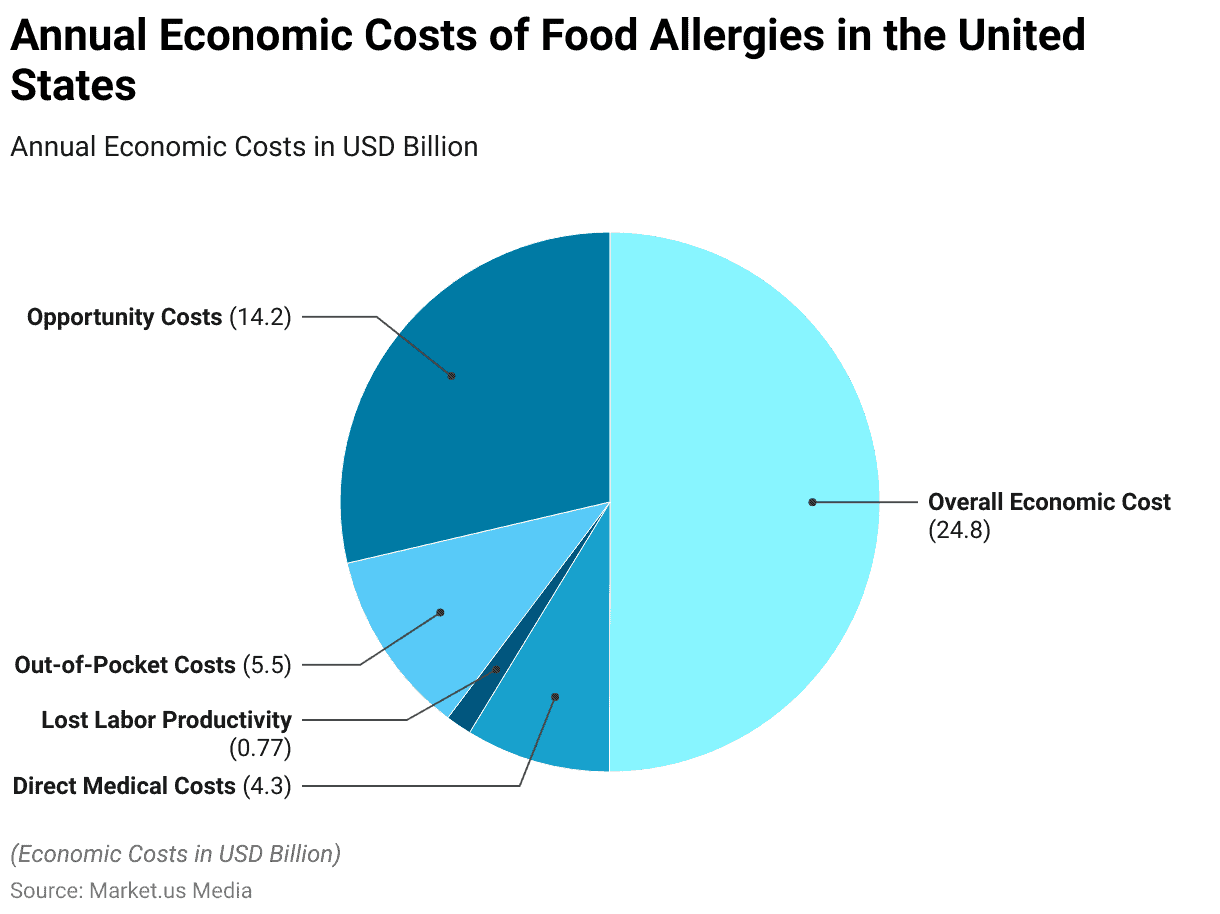
Common Symptoms of Food Allergies
- Skin Reactions:
- Hives (Urticaria): Raised, itchy, and red welts on the skin.
- Eczema: Skin rash characterized by redness, itching, and sometimes blisters.
- Gastrointestinal Symptoms:
- Nausea: A feeling of queasiness or the urge to vomit.
- Vomiting: Forceful expulsion of stomach contents.
- Diarrhea: Frequent and loose bowel movements.
- Respiratory Symptoms:
- Sneezing and Runny Nose: Allergic rhinitis symptoms.
- Coughing and Wheezing: May resemble asthma symptoms.
- Shortness of Breath: This may indicate a severe reaction (anaphylaxis).
- Oral Allergy Syndrome (OAS):
- Itchy Mouth, Throat, or Lips: Often associated with certain fruits and vegetables.
- Swelling: This affects the lips, tongue, or throat.
- Cardiovascular Symptoms:
- Rapid Heartbeat: Palpitations or increased heart rate.
- Low Blood Pressure: Hypotension, a severe sign of anaphylaxis.
- Gastrointestinal Symptoms:
- Abdominal Pain: Cramping and discomfort in the stomach.
- Gastrointestinal Distress: General discomfort, bloating, or gas.
- Anaphylaxis:
- Severe Allergic Reaction: This can involve multiple systems.
- Difficulty Breathing: Airway constriction can be life-threatening.
- Swelling (Angioedema): May affect the face and throat.
- Shock: A dramatic drop in blood pressure and consciousness.
Final Thoughts
Food Allergies Statistics – Food allergies are an increasing global health crisis with serious implications for public health.
Over recent years, their prevalence has steadily risen affecting millions of individuals; although the exact causes remain under investigation.
As awareness, research, and support for those living with food allergies increase exponentially so does awareness for them as an issue requiring further investigation and support – food safety measures.
Take advantage of our unbeatable offer - buy now!

Label transparency education programs must be prioritized to decrease the impact of this widespread issue and enhance the quality of life for those affected by it.
FAQs
Food allergies are relatively common. In the United States, for example, it is estimated that about 32 million people have food allergies, which is roughly 10% of the population. This prevalence can vary by country and region.
The most common food allergens are often referred to as the “big eight.” These include milk, eggs, peanuts, tree nuts, soy, wheat, fish, and shellfish. However, other foods can also cause allergies, so it’s important to be aware of potential allergens in the foods you consume.
Food allergy prevalence appears to be on the rise, but the reasons for this increase are not entirely clear. Some studies suggest that genetics, environmental factors, and changes in diet may play a role. However, more research is needed to fully understand this trend.
Food allergies can range from mild to severe. While some people may experience only mild symptoms, such as hives or an itchy throat, others may have life-threatening reactions known as anaphylaxis, which can lead to difficulty breathing and a drop in blood pressure. Anaphylaxis requires immediate medical attention.
Some children do outgrow their food allergies, particularly those to milk, eggs, and soy. However, allergies to peanuts, tree nuts, and seafood are often more persistent and tend to last into adulthood. Regular evaluation by an allergist is essential to monitor changes in food allergies.
Food allergies are typically diagnosed through a combination of medical history, skin tests, blood tests, and oral food challenges. Elimination diets can also be used to identify specific food triggers.
Discuss your needs with our analyst
Please share your requirements with more details so our analyst can check if they can solve your problem(s)



